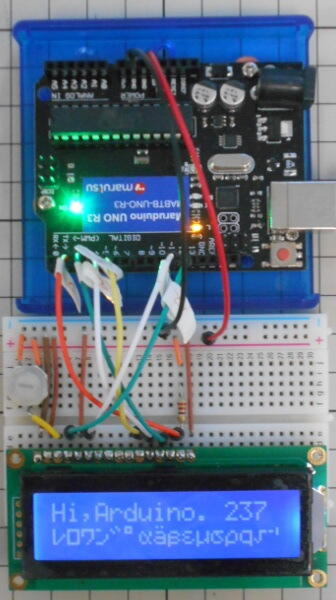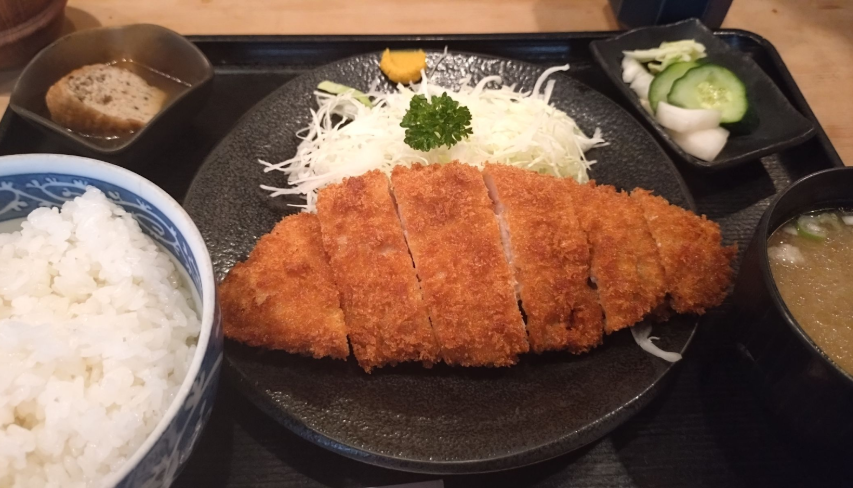Arduino単独では、センサーで得られた情報を表示できない。
センサーを付けて、その値を小さなLCDで良いから表示ししたいものである。
Raspberry Pi の時に使ったものでも表示できるのだが、今回はもっと見やすいバックライト付きのにした。
とりあえず、結果をお見せしよう。
1行目は、”Hi,Arduino.”と表示し、次に起動時からの経過時間を秒単位で表示している。
2行目は、この文字ディスプレイデバイスが持っているCharacter Generaterのパターンを表示している。単なる表示では面白くないし、全256文字を表示してみたいので、どんどんスクロールするようにしてみた。写真では、カタカナの終わりの方と、それに続くギリシャ文字の小文字の初めの方が見えている。
ディスプレイの左上の方に、丸の中に一が見えているのが10kΩの半固定抵抗であり、バックライトの調整に用いる。
このLCDの型番は、ACM1602K-NLW-BBWといい、秋月電子で400円で売っていたものだ。
バックライト付きで、サイズも大きいのに、なぜか非常に安い。よほど売れているからだろうか?
実は、このLCDは、Arduinoの公式ページ内で紹介されているライブラリの Liquid Crystal Library に対応したLCDである。
配線、プログラムは、display() and noDisplay() methodsで完全に分かると思うので、下手な解説は付けない。
実際、この解説通りに結線して、プログラムも流用しただけである。
さらに詳しいYouTubeの解説(Using LCD Displays with Arduino) があり、非常に参考になる(であろう。といのは、英語だし、かなり長いので最後までちゃんとは見ていない。
ここでは、改造して、キャラクタジェネレータの全文字をスクロールしながら表示するように手を入れたプログラムを紹介するに留める。
使用LCD:秋月電子:白色抜き文字表示 LCDモジュール 16x2行 白色バックライト付 (電流制限抵抗実装済み) データシートもあり、キャラクタジェネレータの全文字パターンも載っている。
/*
LiquidCrystal Library - Hello World
Demonstrates the use a 16x2 LCD display. The LiquidCrystal
library works with all LCD displays that are compatible with the
Hitachi HD44780 driver. There are many of them out there, and you
can usually tell them by the 16-pin interface.
This sketch prints "Hello World!" to the LCD
and shows the time.
The circuit:
* LCD RS pin to digital pin 12
* LCD Enable pin to digital pin 11
* LCD D4 pin to digital pin 5
* LCD D5 pin to digital pin 4
* LCD D6 pin to digital pin 3
* LCD D7 pin to digital pin 2
* LCD R/W pin to ground
* LCD VSS pin to ground
* LCD VCC pin to 5V
* 10K resistor:
* ends to +5V and ground
* wiper to LCD VO pin (pin 3)
Library originally added 18 Apr 2008
by David A. Mellis
library modified 5 Jul 2009
by Limor Fried (http://www.ladyada.net)
example added 9 Jul 2009
by Tom Igoe
modified 22 Nov 2010
by Tom Igoe
modified 7 Nov 2016
by Arturo Guadalupi
This example code is in the public domain.
http://www.arduino.cc/en/Tutorial/LiquidCrystalHelloWorld
*/
// include the library code:
#include <LiquidCrystal.h>
// initialize the library by associating any needed LCD interface pin
// with the arduino pin number it is connected to
const int rs = 12, en = 11, d4 = 5, d5 = 4, d6 = 3, d7 = 2;
LiquidCrystal lcd(rs, en, d4, d5, d6, d7);
void setup() {
// set up the LCD's number of columns and rows:
lcd.begin(16, 2);
lcd.clear();
// Print a message to the LCD.
lcd.print("Hi,Arduino.");
}
void loop() {
long tm = millis();
lcd.setCursor(12, 0);
lcd.print(tm/1000);
printchgen(tm/500,16);
delay(500);
}
void printchgen( int st, int n ) {
lcd.setCursor(0, 1);
for( int i=0; i<n; ++i )
lcd.print((char)((st + i) & 0xff));
}
以上。



